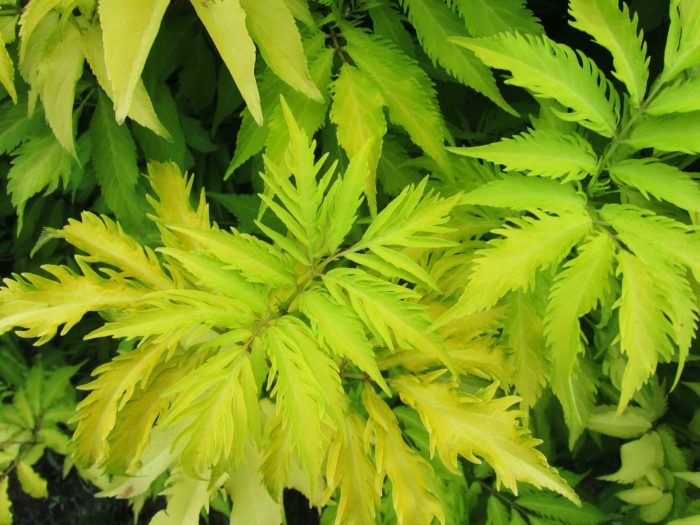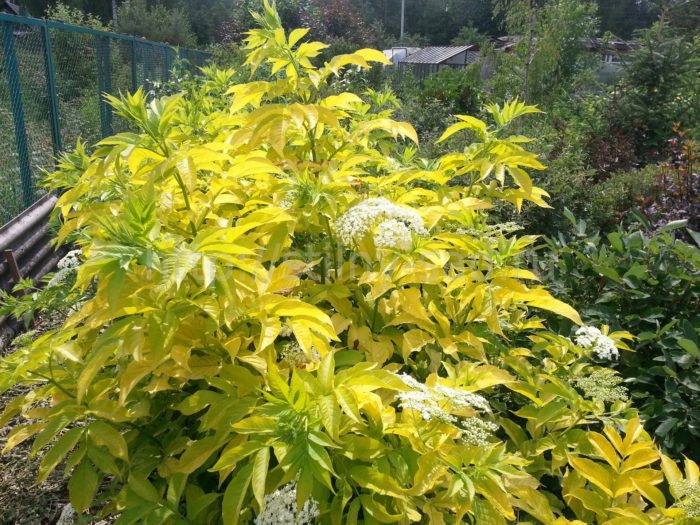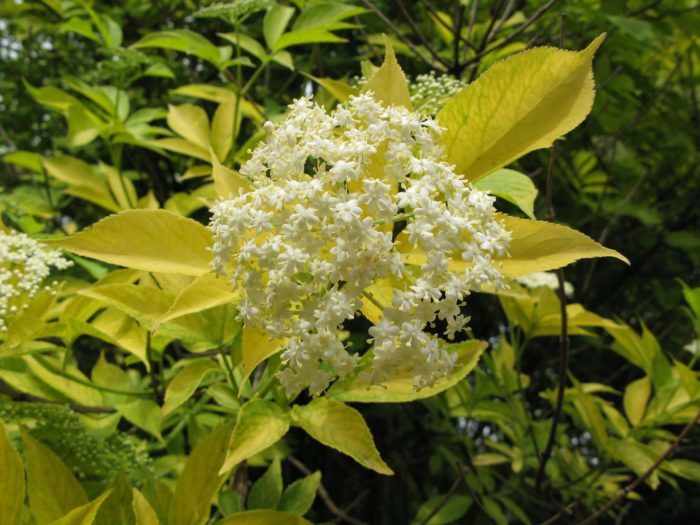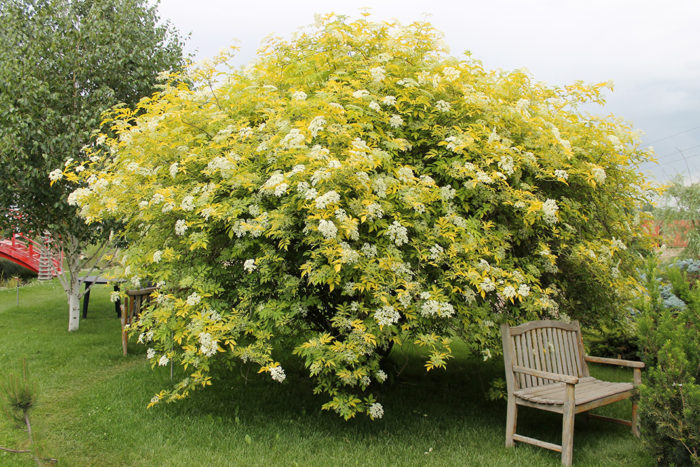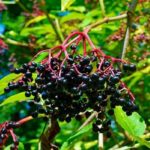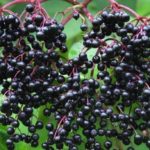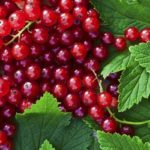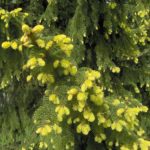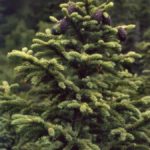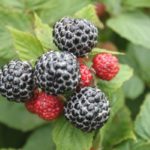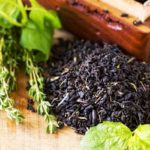We are used to seeing wild elderberry growing in fields and forests. At the same time, there are varieties of this plant that are actively used by landscape designers. Thus, elderberry of the Black Aurea variety is a favorite type of perennial with a beautiful lemon color. In addition, this plant is resistant to severe Russian frosts, and elderberries are used to make jams and compotes, or eaten directly from the garden.
Description of the plant
Elderberry is a small spreading tree or shrub that grows in subtropical or temperate climate zones.More than 15 species are cultivated in Russia. One of the popular cultivated varieties is the black elderberry Aurea. The deciduous shrub of this variety has the following characteristics:
- The height of the bush is up to three meters. The main thick trunk is dark brown, and the young shoots are light green. The fast-flowering dense crown is dome-shaped. To maintain its shape, it needs to be trimmed regularly.
- The leaves are opposite, odd-pinnate, yellow in color and consist of six leaves, reaching up to 25 centimeters in an elongated oval shape. Rough edges with many teeth. By autumn the leaves turn dark green.
- Small flowers that form at the top of young shoots have a light beige tint. Collected in paniculate inflorescences.
- The berries have a diameter of up to six millimeters, a rich purple color, closer to a black tint. The fruits of the plant can only be eaten when ripe.
This perennial is grown throughout the central zone of the Russian Federation, as well as in the southern regions, including the North Caucasus.
One of the varieties of the chokeberry plant is the Canadian elderberry Aurea, which is similar in external properties to the black elderberry, but they have some differences:
- Height – up to 4 meters.
- The inflorescences are slightly larger and collected in panicles, which have a flat shape in the form of umbrellas. Diameter – 20 centimeters.
- The flowers are large and white.
- The leaves are more complex, consisting of seven 30-centimeter leaves.
- Slightly less dense crown.
- The color of the fruit is purple, the size is ten millimeters.
Canadian elderberry has a sharp, specific aroma. Flowering is fast, the fruits ripen in the second year after planting. This crop is more sensitive to frost.
There is also a red-fruited representative of this plant - elderberry cystica Plumosa Aurea. It is advisable for gardeners to know the difference between black elderberry and cluster elderberry, which is used exclusively for landscape design. Here are the main differences:
- Height up to 2.5 meters.
- The leaves are light green in color, turning bright yellow in the autumn months.
- The dense crown is oval and wide.
- This species has good frost resistance.
- The fruits contain hydrocyanic acid in high doses.
Elderberry is known for its unpleasant, pungent aroma, which repels insects and rodents. For this reason, gardeners plant this species next to fruit trees and vegetable crops. The plant blooms quickly, loves abundant watering and requires constant pruning to maintain the shape of the bush. Elderberry Aurea grows throughout the Russian Federation, with the exception of regions where winters are particularly harsh.
How to plant it correctly
Growing black elderberry Aurea seems unpretentious, but requires compliance with some rules. To successfully grow and care for this crop, gardeners adhere to the following recommendations.
Choice of dates
The choice of timing for planting depends on the climate zone. In the conditions of central Russia, black elderberry can be planted in the last days of April, when the soil warms up. In the fall, at the beginning of November, you can also plant, but you need to make sure that there are about ten days left before the onset of frost so that the plant has time to take down strong roots.
Selecting a location
Black elderberry loves sunlit areas, but can also grow successfully in shady areas. It is a self-fertile perennial and therefore does not require pollinators.For better growth and development of the crop, it is recommended to choose fertile soils with a neutral content of acids and alkalis, moist and well-drained.
Planting process
When planting in the spring, select annual planting material that has smooth light green bark and a developed root system. When planting in autumn, it is better to use two-year-old seedlings with healthy roots that do not contain dry fragments. Before planting, the cuttings are placed for ten hours in a container with a solution that stimulates plant growth. Gardeners use the following instructions when planting elderberries:
- Prepare a hole for planting. Diameter – 50 x 50 centimeters, depth – 0.5 meters.
- Mix the topsoil with compost, 60 grams of urea and 200 grams of superphosphate, using about 4 buckets of soil.
- Pour one bucket of mixture into the bottom of the hole. Next, sprinkle with wood ash and distribute the roots. Finally, the roots of the plant are covered with the remaining mixture.
- Drizzle generously over top.
Additionally, it is recommended to mulch - cover the area around the roots with peat.
Aftercare
After planting, black elderberry requires minimal care. You need to water the plant a couple of times a week in hot, dry weather. Gardeners prefer to mulch black elderberry Aurea with compost; no additional fertilizer is required. The plant should be pruned according to the desired shape of the bush or tree. In spring days, you need to remove withered and weakened branches, cut the crown to half its current length. The formation of bushes is carried out annually. There is no need to tie the plant up and cover it for the winter.
Watering and fertilizing
When there is enough natural precipitation in the summer, additional watering is not required. However, on dry days it is worth watering the elderberry at least once every seven days, which is especially important during the flowering period. Elderberry has moderate drought resistance, and when it receives little water, its fruits grow small. The plant does not require additional feeding.
Trimming
To get a good harvest of black elderberry, you need to prune it correctly. An adult tree leaves shoots younger than three years old. On each of the shoots you need to preserve several two-year-old shoots, on which berries will appear in the future. It is worth considering that shoots over four years old give the plant an unpresentable appearance and bear little fruit.
Pest Control
This perennial plant has a fairly strong immune system that is resistant to pests and diseases. However, like any plant, elderberry can sometimes be affected by fungal infections or aphids. For prevention, in the first weeks of spring, bushes should be sprayed with an insecticide. If the plant is affected by powdery mildew, then it is worth treating it with a pesticide called “Fungicide.” Elderberry is rarely damaged by rodents, who avoid it because of its specific smell.
Reproduction
There are several ways to obtain black elderberry:
- Sow seeds in the garden bed in furrows three centimeters deep. The process is carried out in October after the seeds are collected. The seed should be covered for better germination, and the first shoots will appear next spring.
- Cuttings of the upper parts of shoots at one year of age. In the middle of summer, the seedlings are moved to open soil so that it takes root.
- Reproduction using layering. To do this, shoots are dug in and watered abundantly.In this case, the formation of roots will occur in the autumn.
The choice of propagation method depends on the desired time of obtaining the plant. Sowing seeds in a garden bed is the most time-consuming and labor-intensive way to obtain a plant. Cuttings and propagation by layering are more preferable and allow you to get new plants faster.
Application
Black elderberry Aurea is used by gardeners to decorate plots, both as a single shrub and as part of compositions. Here are examples of the use of this plant:
- as color accents on blank walls;
- in the center of the composition;
- as a hedge;
- as protection from the wind;
- in the background design;
- as focal spots;
- as undergrowth for fruit trees.
In addition, it is useful to place Aurea elderberry near resting areas, since the smell of the plant repels insects from sanitary areas.
The berries of the black elderberry Aurea are edible and can be used to make compotes, jams and juice. However, they only form on two-year-old shoots, which should be taken into account when pruning the plant.
Thanks to its spectacular appearance, the black elderberry Aurea occupies a leading position in the design of plots. In addition, the crop is frost-resistant and can be grown throughout Russia. Elder Aurea not only has a beautiful crown, but is also a biologically valuable plant due to the quality composition of its fruits. It grows well and winters even in the middle zone, withstanding cold temperatures down to minus 30°C. If it freezes, the plant quickly recovers.

